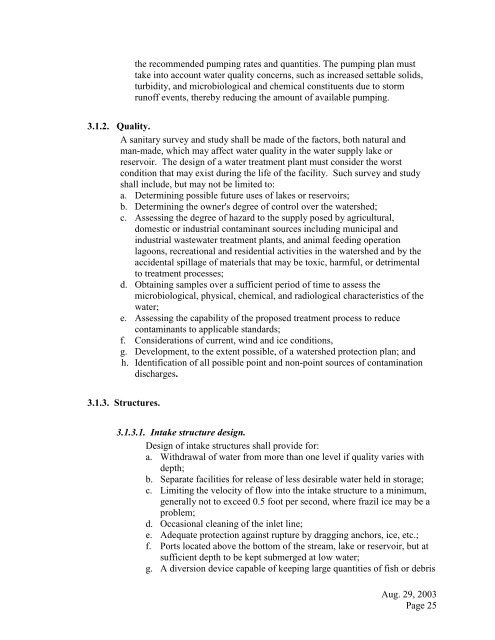Design Guide for Community Water Systems - The Water, Sanitation ...
Design Guide for Community Water Systems - The Water, Sanitation ...
Design Guide for Community Water Systems - The Water, Sanitation ...
You also want an ePaper? Increase the reach of your titles
YUMPU automatically turns print PDFs into web optimized ePapers that Google loves.
the recommended pumping rates and quantities. <strong>The</strong> pumping plan musttake into account water quality concerns, such as increased settable solids,turbidity, and microbiological and chemical constituents due to stormrunoff events, thereby reducing the amount of available pumping.3.1.2. Quality.A sanitary survey and study shall be made of the factors, both natural andman-made, which may affect water quality in the water supply lake orreservoir. <strong>The</strong> design of a water treatment plant must consider the worstcondition that may exist during the life of the facility. Such survey and studyshall include, but may not be limited to:a. Determining possible future uses of lakes or reservoirs;b. Determining the owner's degree of control over the watershed;c. Assessing the degree of hazard to the supply posed by agricultural,domestic or industrial contaminant sources including municipal andindustrial wastewater treatment plants, and animal feeding operationlagoons, recreational and residential activities in the watershed and by theaccidental spillage of materials that may be toxic, harmful, or detrimentalto treatment processes;d. Obtaining samples over a sufficient period of time to assess themicrobiological, physical, chemical, and radiological characteristics of thewater;e. Assessing the capability of the proposed treatment process to reducecontaminants to applicable standards;f. Considerations of current, wind and ice conditions,g. Development, to the extent possible, of a watershed protection plan; andh. Identification of all possible point and non-point sources of contaminationdischarges.3.1.3. Structures.3.1.3.1. Intake structure design.<strong>Design</strong> of intake structures shall provide <strong>for</strong>:a. Withdrawal of water from more than one level if quality varies withdepth;b. Separate facilities <strong>for</strong> release of less desirable water held in storage;c. Limiting the velocity of flow into the intake structure to a minimum,generally not to exceed 0.5 foot per second, where frazil ice may be aproblem;d. Occasional cleaning of the inlet line;e. Adequate protection against rupture by dragging anchors, ice, etc.;f. Ports located above the bottom of the stream, lake or reservoir, but atsufficient depth to be kept submerged at low water;g. A diversion device capable of keeping large quantities of fish or debrisAug. 29, 2003Page 25
















